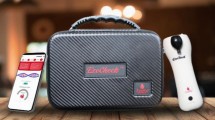Abstract
Nowadays, large number of anaemia cases can be seen especially in women and children. It is caused due to low haemoglobin level in blood. Mostly conventional methods are used to calculate haemoglobin level. These methods involve pricking of human body with needle and sending blood sample to laboratory for further analysis which results in delay and chances of infection increases. This research work is aimed at designing a instantaneous non invasive small, portable and low cost device to determine hemoglobin value in blood which makes it completely mobile. The prototype is based on transmittance type PPG sensor having LEDs and photo detector. The developed prototype capability for hemoglobin detection is validated on 8 subjects by comparing its results with laboratory type digital calorimeter. As a result, the response of prototype has been proved with mean absolute error of 0.7 having a small bias of 0.1 g/deci litre (g/dl) with all data points lie within 95% limits. This shows good agreement and perfect correlation between developed prototype and standard instrument.









Similar content being viewed by others
References
Bruno B, Erin ML, Ines E, Mary C. Worldwide prevalence of anaemia 1993–2005. WHO global database on anaemia 2008. http://www.who.int/vmnis/anaemia/prevalence/en/. Accessed 16 April 2017.
Al-Baradie RS, Bose ASC. Portable smart non-invasive hemoglobin measurement system. Systems, Signals & Devices (SSD), 2013 IEEE Int Conf. 2013: IEEE 1–4. https://doi.org/10.1109/SSD.2013.6564149.
Nestel P, Taylor H. Anaemia detection methods in low-resource settings: a manual for health workers. Program for appropriate technology in health 1997. https://www.path.org/resources/anemia-detection-methods-in-low-resource-settings-a-manual-for-health-workers/. Accessed: 28 April 2017.
Sandeep Patil HG, Ramkumar PS, Prabhu GK, Babu AN. Methods and device to determine hemoglobin non invasively: a review. Int J Sci Eng Technol. 2014;3(7):934–7.
Bhatia K, Singh M. Non-Invasive techniques for detection of haemoglobin in blood: a review. Int J Sci Eng Technol Res (IJSETR). 2015;4(6):1946–9.
Ranganathan H, Gunasekaran N. Simple method for estimation of hemoglobin in human blood using colour analysis. IEEE Trans Inf Technol Biomed. 2006;10(4):657–62.
Bansal PG, Toteja GS, Bhatia N, Gupta S, Kaur M, Adhikari T, et al. Comparison of haemoglobin estimates using direct & indirect cyanmethaemoglobin methods. Indian J Med Res. 2016;144(4):566. https://doi.org/10.4103/0971-5916.200882.
Fricke D, Koroll H, Kraitl J, Ewald H. Blood flow model for noninvasive diagnostics. GCC conference and exhibition, 2011 IEEE international conference on; 2011: IEEE. 343–46. https://doi.org/10.1109/IEEEGCC.2011.5752521.
Kim JG, Xia M, Liu H. Extinction coefficients of hemoglobin for near-infrared spectroscopy of tissue. IEEE Eng Med Biol Mag. 2005;24(2):118–21. https://doi.org/10.1109/MEMB.2005.1411359.
Wang EJ, Li W, Hawkins D, Gernsheimer T, Norby-Slycord C, Patel SN. HemaApp: noninvasive blood screening of hemoglobin using smartphone cameras. Pervasive and ubiquitous computing. 2013 ACM Int Joint Conf. 2016: ACM 593–604. https://doi.org/10.1145/2971648.2971653.
Tamura T, Maeda Y, Sekine M, Yoshida M. Wearable photoplethysmographic sensors—past and present. Electronics. 2014;3(2):282–302. https://doi.org/10.3390/electronics3020282.
Singh M, Jain N. Design and validation of android based wireless integrated device for ubiquitous health monitoring. Wirel Pers Commun. 2015;84(4):3157–70. https://doi.org/10.1007/s11277-015-2792-5.
Singh M, Jain N. Performance and evaluation of smartphone based wireless blood pressure monitoring system using bluetooth. IEEE Sensors J. 2016;16(23):8322–8. https://doi.org/10.1109/JSEN.2016.2597289.
Srinivasan KS, Lakshmi D, Ranganathan H, Gunasekaran N. Non-Invasive estimation of hemoglobin in blood using color analysis. Industrial and information systems, 2006 IEEE Int Conf. 2006: IEEE. 547–549. https://doi.org/10.1109/ICIIS.2006.365788.
Allard M. Accuracy of noninvasive hemoglobin measurements by pulse co-oximetry in hemodilution subjects. Anesthesiol A. 2009;184:1–4.
Macknet MR, Norton S, Kimball-Jones PL, Applegate RL, Martin RD, Allard MW. Noninvasive measurement of continuous haemoglobin concentration via pulse CO-oximetry. CHEST J. 2007;132:493–4.
Macknet MR, Norton S, Kimball-Jones P, Applegate R, Martin R, Allard M. Continuous noninvasive measurement of haemoglobin via pulse CO-oximetry. Anesth Analg. 2007;105(6):S108–9.
Torp KD, Aniskevich S, Shine TS, Shapiro DP, Peiris P. Validation of a new noninvasive hemoglobin algorithm in patients undergoing liver transplantation. Anesthesiology A. 2009; 751.
Lamhaut L, Apriotesei R, Lejay M, Vivien B, Carli P. Comparaison between a new non-invasive continuous technology of spectrophotometry-based and RBC count for haemoglobin monitoring during surgery with hemorrhagic risk: 3AP71. Euro J Anaesthesiol (EJA). 2007;27(47):60–1.
Hadar E, Raban O, Bouganim T, Tenenbaum-Gavish K, Hod M. Precision and accuracy of noninvasive hemoglobin measurements during pregnancy. J Matern Fetal Neonatal Med. 2012;25(12):2503–6. https://doi.org/10.3109/14767058.2012.704453.
Sarkar PK, Pal S, Polley N, Aich R, Adhikari A, Halder A, Chakrabarti S, Chakrabarti P, Pal SK. Development and validation of a noncontact spectroscopic device for hemoglobin estimation at point-of-care. J Biomed Opt, 2017;22(5):55006. https://doi.org/10.1117/1.JBO.22.5.055006.
Author information
Authors and Affiliations
Corresponding author
Ethics declarations
Conflict of interest
The authors declare that they have no conflict of interest.
Ethical approval
This article does not contain any studies with human participants or animals performed by any of the authors.
Informed consent
Not applicable.
Rights and permissions
About this article
Cite this article
Bhatia, K., Singh, M. Towards development of portable instantaneous smart optical device for hemoglobin detection non invasively. Health Technol. 9, 17–23 (2019). https://doi.org/10.1007/s12553-018-0247-1
Received:
Accepted:
Published:
Issue Date:
DOI: https://doi.org/10.1007/s12553-018-0247-1




